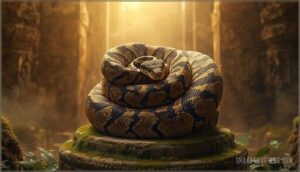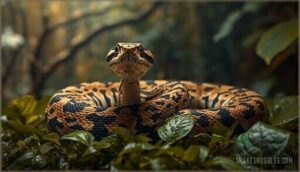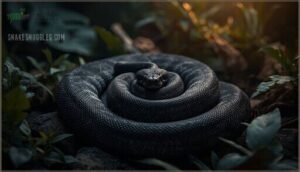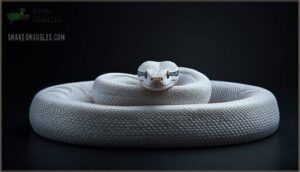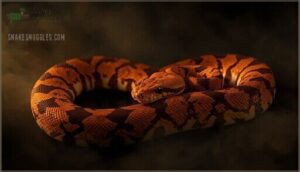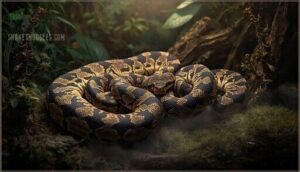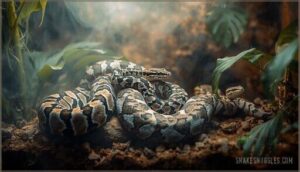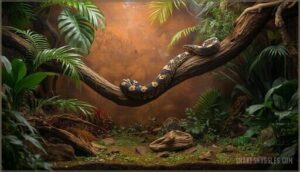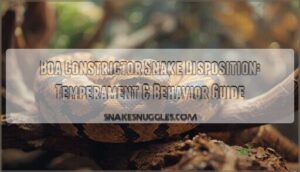This site is supported by our readers. We may earn a commission, at no cost to you, if you purchase through links.

The chase for these one-of-a-kind patterns isn’t driven by trend alone; it’s a quest for mastery, a push to reveal nature’s secrets. If you’re ready to break from the predictable and discover how genetics, ecology, and bold breeding shape these extraordinary reptiles, you’re in the right place.
Table Of Contents
Key Takeaways
- Rare boa morphs arise from specific genetic mutations that influence color, pattern, and even health, making each snake a unique expression of evolutionary artistry.
- Ethical breeding and rigorous health screening are essential to prevent defects and ensure that rare morphs remain both visually striking and healthy.
- The value and scarcity of these morphs are shaped by genetics, selective breeding, market demand, and natural isolation, driving collectors to seek out the most distinctive patterns.
- Proper care—including precise habitat control, nutrition, and gentle handling—is crucial for maintaining the wellbeing and vibrant appearance of rare and unique boa morphs.
What Makes a Boa Morph Rare?
Rarity in boa morphs comes down to genetics, unique patterns, and how often you see them in the trade. Some morphs stand out for their uncommon colors or the way their genes interact.
Let’s look at the factors that set these rare beauties apart.
Genetic Mutations Behind Unique Morphs
Curiosity drives you to unravel the secrets of rare boa morphs, where gene expression and mutation types shape color genetics and pattern formation. Genetic diversity flourishes through three main genetic mutations:
- Melanin pathway mutations—albino, hypo, and Super Fire morphs.
- Erythrin and xanthin pigment gene changes—anerythristic and Blood boas.
- Structural mutations—Aztec, Jungle, and Motley pattern morphs.
Each mutation unlocks distinct visual artistry. Understanding the genetics behind boa morph genetics is essential for breeders and enthusiasts alike.
Distinguishing Morphs From Defects
You can’t take rare genetics at face value—sometimes what catches your eye is a red flag, not a prize. Morph Identification relies on consistent color and pattern from genetic mutations, not physical defects.
Genetic Testing and Health Screening separate true Boa constrictor morph characteristics from hidden recessive genes that trigger jaw kinks, stargazing, or blindness.
Breeding Ethics demand Defect Prevention, keeping rare morphs healthy—not just beautiful. Understanding genetic morph basics is essential for identifying and breeding unique boa constrictors.
Factors Driving Rarity in Morphs
Spotting rare boa constrictor morphs means looking past the surface. Genetic mutations and low mutation rates keep unique traits scarce, while recessive genes demand careful breeding strategies.
Genetic drift, especially in island isolation, locks in rare variations—think Cayos Cochinos dwarfs.
Market demand spikes prices as collectors chase investment-grade morphs. Ultimately, rarity reflects a blend of genetic traits, selective breeding, and natural isolation.
Most Sought-After Rare Boa Morphs
Some boa morphs stand out for their rarity and striking looks. These snakes often become the centerpiece of serious collections. Here are a few of the most sought-after morphs you’ll want to know about.
Aztec Boa
Ever seen a boa whose pattern looks like ancient architecture? The Aztec Boa is a living mosaic, defined by incomplete dominant Aztec Genetics.
Its ladder-like Color Patterns and smeared dorsal stripes set it apart in Boa Morphology.
Breeding Techniques reveal co-dominant Morph Classification, with “Super Aztec” forms showing intense hues—yet facing challenges like partial infertility and neurological wobble.
Leopard Boa
Leopard Genetics rewrite the rules of Boa Morphology, giving you a morph that’s as rare as it’s hypnotic. With spots, stripes, and “whiskered” faces, the Leopard Boa stands apart. If you’re chasing mastery, note these essentials:
- Distinct Color Patterns and facial markings
- Recessive Breeding Techniques
- Habitat Design for dwarfed adults
- Hypo Leopard and Albino Leopard variants
IMG (Increased Melanin Gene) Boa
Black pigment is your badge of rebellion with the IMG Boa. IMG Genetics drive Melanin Expression, transforming each shed into a darker masterpiece. Co-dominant Traits mean Morph Breeding unlocks super forms—sometimes jet black, sometimes striking contrast. This morph’s unpredictable evolution is a reflection of genetic mutations in Boa morph genetics.
| Trait | Description |
|---|---|
| Melanin | Progressive blackening |
| Genetics | Co-dominant |
| Breeding | Super forms possible |
| Pigmentation | Intensifies with sheds |
| Hypomelanistic | Contrasting variants |
Snow Boa
White brilliance—Snow Boa Genetics are your ticket to the rarest pigment play in Boa constrictor Morph Breeding. These boas combine albinism and anerythrism, yielding silvery Color Patterns and subtle Iridescence Effects.
Neonates flash faint lavender; adults shimmer with Snowglow or Hypo variations. If you crave genetic mastery, this morph’s impeccable palette is pure rebellion.
Super Fire Boa
If you’re chasing the summit of Fire Gene Expression, the Super Fire morph is your white-hot prize. Complete Leucistic Traits and jet-black eyes set it apart from other Boa constrictor color morphs.
Mastering Fire Genetics and precise Breeding Techniques is essential, with Morph Market Trends pushing values skyward for confirmed Black Eye Morphs and pure Fire Boa lineages.
Other Notable Rare Morphs
Ever wondered what sets the rarest boa morphs apart? Morph Market Trends reveal that rarity often hinges on unique gene combinations and bold Boa Color Variations. For instance, consider these standouts:
- Eclipse Boa: Co-dominant Rare Pattern Genetics.
- Paradigm Boa: Double heterozygous lines.
- Moonglow Rosy Boa: Snow, Hypomelanistic, and Albino genes woven together.
Unique Morph Combinations and Patterns
When you mix and match boa morphs, the results can be truly striking. Some combinations create patterns and colors you won’t see anywhere else.
Let’s look at a few standout examples and what makes them unique.
Sunglow Morphs
If you crave a boa that turns heads, the Sunglow morph is your ticket. Its genetic heritage—melding albino and hypo genes—drives color intensity and morph pricing skyward.
Breeding strategies focus on precise gene pairing, while care requirements mirror standard boa constrictor morph basics.
Sunglow boas exemplify how genetic variations can reshape beauty in captive-bred designer reptiles.
Ghost Morphs
If Sunglow boas are fireworks, Ghost morphs are moonlight—subtle, silvery, and haunting. You’ll spot their Genetic Expression in pale gray Color Patterns, thanks to the blend of Anery and Hypomelanistic genes. For Morph Identification, consider these:
- Reduced melanin
- Absence of red pigment
- Lavender tails
- Selective Breeding Techniques and precise Habitat Requirements
Jungle and Motley Combinations
Shifting from the spectral allure of Ghost boas, Jungle and Motley combos are the rebels of boa morph genetics. Pattern expression here is unpredictable—think bold ladder-striping tangled with broken saddles, thanks to combo breeding.
Super forms push boundaries but beware: lethal alleles often lurk, making responsible pairing essential. Each Jungle Motley is a living tapestry of genetic variations and color morphs.
Hypomelanistic and Anerythristic Mixes
When you pair Hypomelanistic with Anerythristic genetics, you reveal the “Ghost” boa—one of the rare morphs where Color Genetics and Morph Patterns intersect.
These snakes, stripped of red and black pigment, flaunt pastel silver and lavender tones.
Breeding Techniques for double recessive genes make them scarce, showcasing the bold artistry of Genetic Expression behind boa morphs.
Genetics Shaping Rare Boa Morphs
Genetics are at the heart of every rare boa morph, shaping their colors, patterns, and even health. Understanding how traits are inherited can help you make sense of what sets each morph apart.
Let’s look at the key genetic factors that influence these exceptional snakes.
Dominant, Recessive, and Co-dominant Traits
Ever wondered how boa morphs get their wild looks? Genetic Inheritance is the engine behind Trait Expression—dominant, recessive, and codominant genes dictate Morph Breeding outcomes. Each genetic mutation, from dominant Jungle to recessive Albino, follows distinct Heritability Patterns. Here’s what shapes your boa’s unique traits:
- Dominant genes
- Recessive genes
- Codominant gene interaction
- Genetic variations in trait expression
Polygenic Inheritance in Pattern Formation
Pattern genetics in boas is a tapestry woven by polygenic expression and intricate gene interaction. Instead of a single mutation, morph development relies on the additive effects of multiple genetic variations.
These subtle shifts drive color variation, saddle shapes, and pigment production. Genetics behind boa morphs isn’t just about one gene—it’s a symphony of morph genetics playing out in every scale, every blotch.
Ethical Breeding for Healthy Morphs
Integrity defines ethical practices in boa morph breeding. You can’t chase rarity at the cost of animal welfare. Breeding Standards demand Genetic Testing and Health Screening, so you’re not just rolling the dice with Morph Selection.
Ethical boa morph breeding means valuing animal welfare above rarity, with genetic testing and health screening as essential standards
Responsible breeding practices—like outcrossing and avoiding high-risk pairings—preserve genetic variations. Breeder Ethics means respecting the Genetics behind boa morphs, not just breeding common morphs for quick profit.
Caring for Rare and Unique Boa Morphs
Caring for rare boa morphs starts with creating the right environment. Your setup plays a huge role in their health and behavior. Here’s what you need to think about when choosing their enclosure.
Habitat and Environmental Needs
Imagine crafting a microclimate masterpiece—your boa’s habitat demands precise Temperature Control and Humidity Management.
Enclosure Design is critical: spacious dimensions, layered substrates, and sturdy Ventilation Systems prevent stagnation.
Lighting Systems must mimic natural cycles, supporting healthy rhythms.
Every environmental factor, from temperature, humidity, and lighting, directly shapes your morph’s color, health, and behavior. Bold choices yield thriving, unique boas.
Diet and Nutrition for Morph Health
How do you keep those rare color variations glowing with health? It’s all about precise Feeding Strategies and Nutrient Balance.
Meal Frequency varies—juveniles thrive on weekly feeds, while rare morphs need slower intervals for Digestive Health. Skip unnecessary Dietary Supplements if your prey is high-quality.
Dial in diet and nutrition for different morphs—masterful boa morph care starts here.
Handling and Socialization Tips
Ever notice how a boa’s confidence grows with every gentle interaction? Responsible ownership means mastering Handling Techniques that respect Snake Behavior and prioritize Stress Reduction. Your Socialization Methods shape temperament and trust—here’s how:
- Start with short, calm sessions
- Avoid handling post-feeding
- Use low lighting for juveniles
- Support the full body
- Pair touch with verbal cues
Health Monitoring and Veterinary Care
Think your boa’s colors are the only thing worth watching? Disease Diagnosis and Health Screening are just as essential. Annual Veterinary Exams catch issues early—like IBD or Cryptosporidium—while Parasite Control and Medical Treatment keep snake health on track. Smart monitoring ensures your reptile thrives, especially with rare genetic mutations. Here’s a quick guide:
| Checkup | Method | Benefit |
|---|---|---|
| Disease Diagnosis | PCR, Radiography | Early detection |
| Health Screening | Visual, Fecal | Prevent outbreaks |
| Parasite Control | Praziquantel | Reduce risk |
| Medical Treatment | Vet-directed | Boost recovery |
Frequently Asked Questions (FAQs)
How do rare boa morphs affect resale value?
Like a rare gem in a crowded market, rare boa constrictor morphs command premium snake morph prices. Genetics behind rare morphs drive price fluctuations, with breeding costs and market trends shaping resale strategies and the genetic value of unique color morphs.
What are common myths about rare boa morphs?
Morph Misconceptions run deep—people often think rare boa constrictor morphs are all alike, or unhealthy, or naturally wild.
In reality, Boa Genetics, Rare Patterns, and Breeding Ethics drive market trends and genetic mutations, not myth.
Can rare morphs be found in the wild?
Rare boa constrictor morphs do occur in wild populations, but Wild Morph Occurrence is exceptionally rare.
Natural Genetic Variation yields Unique Boa Constrictor Color Morphs, yet survival rates for Rare Color Patterns remain low due to Wild Population Genetics.
Are rare boa morphs more sensitive to stress?
Under pressure, boa morphs with genetic variations—such as Hypomelanistic, Anery, or Hypo—often display a heightened stress response.
Environmental factors and genetic predisposition can spike cortisol levels, leading to immune suppression and increased sensitivity compared to standard boas.
How does market saturation impact rare morph prices?
When supply outpaces demand, Boa constrictor morph prices—especially for rare and exotic boa constrictor morphs—decline.
Market Trends and Price Volatility reflect oversupply, prompting Breeder Strategies like diversification or price cuts, reshaping Snake morph prices and economic factors.
Conclusion
Imagine a boa gliding through dappled light, its scales shimmering with patterns that defy expectation. Rare and unique boa morphs are more than genetic anomalies—they’re nature’s living canvas, shaped by selective breeding and evolutionary chance.
Your pursuit of these exceptional reptiles isn’t just about collecting; it’s a commitment to understanding genetic intricacies, ethical care, and the artistry woven into every scale. Each morph you encounter is a demonstration of the bold possibilities hidden within the realm of boas.

